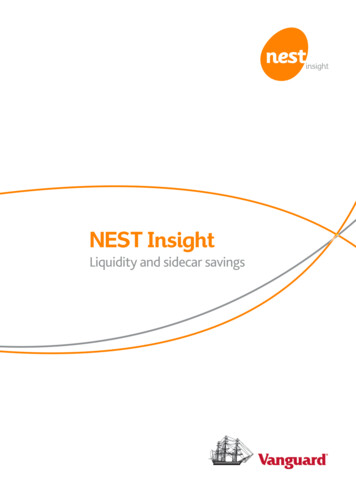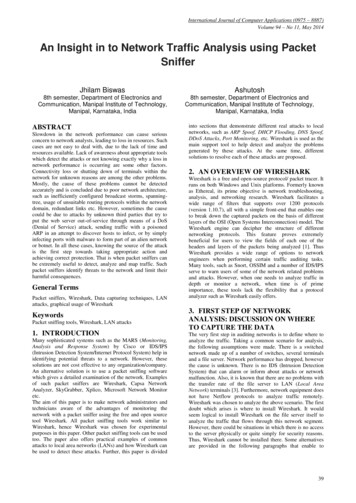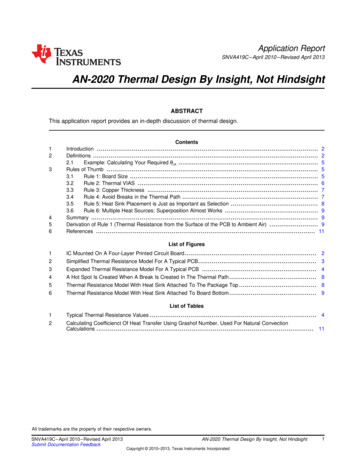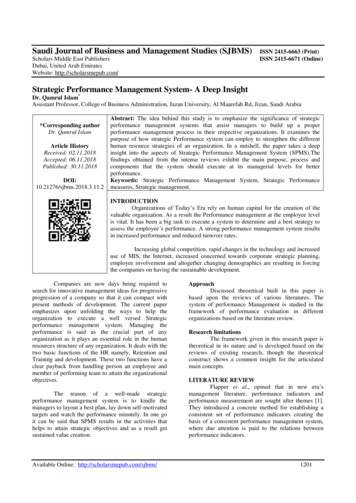
Transcription
NEST InsightLiquidity and sidecar savings
2NEST InsightNEST Insight is a research unit set up by NEST Corporationto help understand and address the challenges facing NESTmembers and the new generation of defined contribution(DC) savers.NEST CorporationNEST Corporation is the Trustee of NEST. It wasestablished by legislation to run the NEST pension scheme.As a non-departmental public body, NEST Corporation isaccountable to Parliament through the Department forWork and Pensions but is generally independent ofgovernment in its day-to-day decisions.About our strategicpartner, VanguardVanguard was founded with the purpose of taking a standfor all investors. In pursuit of this principle, Vanguard isproud to be the first strategic partner of NEST Insight, in itseffort to help the UK public achieve the best chance ofinvestment success, and a comfortable retirement.With the route to retirement becoming increasinglycomplicated, Vanguard believes that improving theunderstanding and accessibility of the UK pension systemwill be vital in generating practical solutions to thechallenges ahead.Since establishing the first indexed mutual fund in 1976,Vanguard has grown into one the world’s largest and mostrespected investment management companies. GloballyVanguard manages 3.4 trillion on behalf of investorsworldwide (source: Vanguard, as at 31 June 2017). Formore information visit: www.vanguard.co.uk
3Liquidity and sidecar savingsAuto enrolment is creating a new generation of savers across theUK. Millions of people are building retirement savings, often for thefirst time, yet many of them have little or no money on hand toprotect them from the effects of unexpected financial shocks.An innovative new behavioural approach may offer a solution.Policy and social contextFor some time, policy-makers have promoted initiatives to encourage, on the one hand,liquid short-term savings, and on the other, illiquid retirement savings. These two types ofinitiative are generally considered and undertaken in isolation, without a clear sense of howthey might interact. At best this treats the two timeframes as independent. At worst itsuggests that they must be traded off in a zero-sum game, where each competes for a fixedshare of an individual’s assets.In the UK, the public policy response to the challenge of encouraging retirement saving isrelatively advanced. We offer people a comprehensive system of incentives and regulation toget them to save for retirement and to protect those savings. Recently, this has beenstrengthened by the introduction of auto enrolment which requires all UK employers by lawto enrol their eligible workers into a workplace pension scheme that meets certain standards.This has resulted, so far, in over 8 million people newly saving, or saving more, for theirretirement. By almost any measure, the initiative has been a huge success.By contrast interventions to encourage greater levels of liquid saving have been lesscomprehensive and the results patchier, especially at lower incomes.Initiatives include:Financial inclusion: A focus on financial inclusion has dramatically reduced the number ofpeople defined as ‘unbanked’, ensuring access to at least basic current account functionsfor around an additional 1.1 million people as at 2010.1Increased tax-free savings allowance: The introduction of cash and maxi-ISAs, and morerecently a general increase in the tax-free savings allowance, has sought to increase accessto, and the desirability of, shorter-term and more liquid savings accounts.Offering a credit match on savings: The Savings Act 2017 introduced a savings creditmatch for those on lower incomes along similar lines to that tested through the SavingsGateway pilot in the 1990s. The Lifetime ISA which was subsequently launched in April2017 offers a significant government matching element to a product that has, in part, anearer-term goal.Elllison, A., Whyley, C. and Forster, R. (2010). Realising Banking Inclusion: the achievements and challenges. London: HM Treasury1
4In spite of these initiatives to incentivise liquid savings, 26 per cent of working-age adultshave no rainy-day savings, and only 42 per cent have 500 or more on hand.2 This leavesmany people at risk of short-term financial shocks which can have a severe impact on theirlives.High-cost and unpredictable one-offexpenses such as the breakdown of ahousehold appliance can cause acute shortterm financial hardship for people whosedisposable income after essentials is low.3In addition, financial shocks among lowincome groups can lead to debt spirals whichcan cause acute financial stress. Any severeor persistent pressure on liquidity can havesignificant health effects, which can in turnaffect productivity and earning capacity.426 per cent of workingage adults have norainy day savings, andonly 42 per cent have 500 or more on handFour in ten workers say money worries have madethem feel stressed over the last year.A quarter (25 per cent) say they have lost sleep overmoney worries.One in eight workers report that money worries haveaffected their ability to concentrate at work.One in twenty workers (6 per cent) have missed workin the last year due to money worries.5Less dramatically, relatively small-scale financial shocks can still take many months to fullyrecover from. While we are aware of only limited equivalent evidence in the UK, research inthe US suggests that the impact of even relatively small short-term financial shocks can stillhave an impact on household finances as much as a year later.6Money Advice Service (2016) UK Financial Capability Strategy for working-age people. London:Money Advice Service. Department for Work and Pensions(2017) Family Resources Survey. London: Department for Work and Pensions3See for instance: Money Advice Service (2016) UK Financial Capability Strategy for working-age people. London: Money Advice Service.Packman, C. (2017) Savings for the Future: Solving the Savings Puzzle for Low Income Households. London: Toynbee Hall4Money Advice Service, op cit; Chartered Institute of Personnel and Development (2017) Financial well-being: the employee view. London: CharteredInstitute of Personnel and Development5Social Market Foundation (2016). Working well: how employers can improve the wellbeing and productivity of their workforce. London: Social MarketFoundation.6JPMorgan Chase Institute (2017) Coping with Costs – Big Data on Expense Volatility and Medical Payments. London: JPMorgan Chase & Co.2
5Mental accountingIn practice, people’s finances are highly interconnected. It is true that people tend to managetheir finances in distinct ‘jars’ for distinct goals, either literally or metaphorically. This isknown in the literature as mental accounting.7 But the goals themselves are not independentand there are clear risks that the breakdown of one can negatively impact others.When finances are squeezed and an unexpected expenditure is required, cancelling pensioncontributions is one way to free up cash. In an extreme case, one could imagine for example,a short-term financial shock such as the inability to afford a car repair having dramaticknock-on consequences such as loss of earnings and increased debt.Because these goals are interconnected,people need to be able to move resourcesbetween jars. In practice, where they cannot,the outcomes can often be sub-optimal. Inthe absence of liquid savings, the mostcommon mechanisms for fundingunexpected peaks in consumption or falls inincome are borrowing, through credit cards,personal loans or ‘payday’ loans, or fromfriends and family or, where possible,reductions in ‘essential’ spending. All thesemechanisms can be sensible parts of anoverall financial ‘portfolio’8, but are often atbest inefficient. These methods can, forexample, result in people simultaneouslyservicing a high-cost debt while incurringrelatively lower offsetting returns on anysavings that do exist.In practice, people’sfinances are highlyconnected. It is truethat people tend tomanage theirfinances in distinct‘jars’ for distinctgoals, either literallyor metaphoricallyThe interaction between retirementsaving and liquid savingAuto enrolment has extended participation in workplace pensions by more than 8 millionpeople. A significant proportion of these people are those on lower and moderate incomes,who are the most at risk of a lack of liquidity.NEST’s membership has an average income of around 18k, compared to the nationalmedian of 24k. Before auto enrolment, the average income among active pension saverswas 35k. This throws into sharper relief the mismatch between long- and short-termsavings.Thaler, R. H. (1985) Mental accounting and consumer choice. Marketing Science, 4(3), 199-214.See for instance: Gathergood, J., Guttman-Kenney, B. and Hunt,S. (2015). How do payday loans affect UK consumers? United States: The National Bureauof Economic Research.78
6To add to this, 42.3 per cent of NEST members fall into the Money Advice Service’s (MAS)‘squeezed’ segment compared to a national average of 24.9 per cent. Amongst othercharacteristics, this group of people are described by MAS as follows:Many are financially insecure, though few recognise the reality of their situation and do notconsider themselves in need of help.They’re unable to cope with unexpected costs, even relatively minor ones, because theirmonthly budgets have very little ‘give’ and typically they have nothing in reserve.Though some lack discipline to save regularly, many have few or no savings because a largeproportion of their household income is directed to the servicing of debts.It’s also often the case that they can only cope with unforeseen expenses by taking onadditional debt.They often ignore their money related issues, which if addressed could improve theirfinancial situation. Examples include extravagant behaviour, such as frequently eatingexpensive takeaways or going out when they cannot really afford to, or ignoringbackground issues such as large credit card balances and big overdrafts which roll on yearafter year.9People in this group, and the broader demographic, are starting to build up meaningfulsavings, yet they still lack the liquidity to manage even relatively small financial shocks andsubsequent debt spirals.This has, on occasion, led to suggestions that the defined contribution (DC) retirementsystem should be opened up by introducing some element of pre-retirement liquidity. Thismight perhaps be achieved through hardship withdrawals or a loan facility along similar linesto the US 401k system.When HM Treasury issued a call for evidence on this topic in 2011 they concluded it shouldnot be pursued. This was predominately because the evidence in support of allowing earlyaccess was limited and inconclusive, and there were concerns that doing so would negativelyimpact retirement outcomes, particularly because of the risk of leakage. At the time of theconsultation there were also a number of pension reforms already underway, most notablythe implementation of auto enrolment, and the impact of the changes remained to be seen.10However, given the clear need for greater emergency savings in this population, and thebuild-up of their assets facilitated by auto enrolment, the issue continues to be at theforefront for many.9The Money Advice Service (2016). The Squeezed Segment. London: Money Advice ServiceHM Treasury (2011) Early access to pension savings: a summary of responses to the call for evidence. London: HM Treasury10
7Although intuitively attractive, allowing people access directly to their retirement potscreates a number of issues:Individual DC accounts are investment products which, for most of a working life, shouldhave a relatively high risk exposure. They are not designed to be instantly accessible andseeking to access them in an emergency could lead to very bad value if done at a low pointin asset values. If anything, the trend in institutional DC investment is towards greaterilliquidity as DC schemes try to mimic some of the strategies employed by successful largedefined benefit (DB) plans.There’s a risk that savers could withdraw an excessive amount of their pension potpre-retirement, leaving them very little for later life.Administering withdrawals from administration systems not designed for the purpose maywell introduce significant costs, which could erode the value of what savings are left. Ifwithdrawals are conditional, for example based on hardship, someone has to verify thatconditions are met and this adds further cost.The tax treatment of pensions is designed to suit deferred consumption, that is, you aretaxed at the point you receive the money as income. In an early withdrawals model, wherethe money has been saved tax-free, some kind of tax payment or penalty wouldpresumably be required on the withdrawal.Hybrid productsAllowing early access to retirement savings seeks to make a product designed for onepurpose instead serve multiple purposes. An alternative is to think about how to create anexperience which fits with the customer’s psychology and preferences, for example onewhich feels like a single ‘product’ but contains within it distinct ‘jars’ for different purposes.That in turn enables the underlying product design to reflect different purposes in differentdesign treatments. This is the idea behind ‘hybrid’ financial products, a concept advanced by,among others, the Aspen Institute in the US. They describe hybrid financial products in thefollowing way:‘Traditional financial products have typically been designedaround single financial functions—borrow, save, pay, transact,invest, or insure. “Integrated” and “hybrid” solutions combine twoor more financial functions to enable consumers to address theirfinancial needs as they arise.’While the description of this category of product is new, the idea itself is not. Offsetmortgage and savings products could be thought of as hybrids. In the retirement space, the‘retirement income blueprint’ published by NEST in 2015 proposes a hybrid structure forpaying income from a DC pension through a product that incorporates invested drawdown,insurance and short-term liquidity functions.
8Applying the hybrid concept toemergency and retirement savingsIn the US, unlike the UK, people do have pre-retirement access to their DC pension savings,either in the form of hardship or other loans, or complete access at the point of a job move.The consequence of this has been a considerable amount of leakage from the US DC system.Some estimates11 suggest as much as 40c in every 1 saved leaks from the systempre-retirement.Researchers at the Behavioural Insight Group at the Harvard Kennedy School in the US haveoffered12 an alternative prescription to this early access model but with more of a hybrid-stylesolution. They present evidence that there is a potentially optimal balance between liquidand illiquid savings, and go on to propose greater integration between these systems. Theirproposed mechanism, the ‘sidecar’ account, builds on the success of auto enrolment byadditionally introducing an optimised level of liquid savings.The sidecar modelIn a sidecar structure, contributions would be managed through a mechanism designed tocreate an optimal level of liquid savings, while also maximising long-term savings. This wouldbe administered as follows:1. Contributions paid into the combined account structure would at first be distributedbetween the liquid and illiquid accounts.2. When the balance in the liquid account reaches a predetermined threshold level, known asthe ‘savings cap’, all contributions would start ‘rolling’ into the illiquid retirement account.3. If at any point the saver withdraws funds from the liquid account, and so reduces thebalance to a level below the savings cap, future contributions would once again start beingdivided between the liquid and illiquid accounts.Payroll contributionssavings capLiquidaccountPension pot11Bipartisan Policy Center (2016). Securing our financial future: Report of the commission on retirement security and personal savings. United States:Bipartisan Policy Centre.12See for instance: Beshears, J., Choi, J., Clayton, C., Harris, C., Laibson, D. and Madrian, B. (2014). Optimal Illiquidity. United States: University of California.
9Benefits of the sidecar modelThis relatively simple mechanism offers a number of potential attractions.First, it reflects the logic of a hybrid product by recognising that different financial productswith different financial goals are likely to have different design features. This model allows arisk-taking investment strategy in the pensions element without the risk of unexpectedliquidity requirements, while allowing a more traditional savings or deposit account model forthe liquid element.Secondly, while creating distinct products for retirement and shorter-term liquidity, thesidecar model could mimic a number of the features that have already been proven to helpincrease retirement savings. Most notably such a product would be offered through payrolldeduction in the workplace, leveraging the idea of ‘set and forget’ to create a persistent flowof contributions to savings.Thirdly, such a system helps serve thevarying needs of different savers. Forinstance, it caps the level of liquid savings,while maintaining a relatively open-endedrate of retirement contributions. In this wayit seeks to generate an appropriate balanceof liquidity for each individual saver. Theresearchers argue that this will enhance theoverall financial wellbeing of individualsavers, both in the short term and throughinto retirement. For instance if an individualputs money into a liquid ‘rainy day’ savingsaccount, and then spends it in the shortterm, this might lead to a lower retirementaccount balance than if they’d invested thismoney into a pension plan. However, if theirshort-term saving enabled them to avoid adamaging short-term financial shock, avoidcostly personal debt, or secure homeownership, the benefits of this short-termsaving should continue to be felt rightthrough into retirement.It reflects the logic ofa hybrid product byrecognising thatdifferent financialproducts withdifferent financialgoals are likely tohave different designfeaturesAnd finally, a combined savings structure may also be both more suitable and moreattractive to individuals than either short- or long-term savings products on their own.13 TheAspen Institute’s work explicitly points to the potential for hybrid products to aid financialresilience among low income groups because they enable differentiated products to fit morenaturally with the financial lives and preferences of individuals than would be the case forseveral disparate products.14 Hybrid products might therefore help increase overall savingslevels.This hypothesis will be tested in the qualitative element of the project’s formative phase.Lucas McKay, K. (2017) Two birds, one stone: using hybrid financial products to manage income volatility. United States: Aspen Institute1314
10Such an approach is also highly consistent with the behavioural literature in a number ofways. In particular:It fits with the idea of mental accounting, with people most comfortable thinking abouttheir finances in distinct goal-based ‘pots’.As a mechanism for increasing retirement saving specifically, it fits with the logic behind‘auto-escalation’ schemes.15 It makes use of procrastination bias, by allowing people tomake a commitment without having to surrender that money straight away.It also helps manage short-term bias and hyperbolic discounting. That is, people are likelyto be more comfortable saving to cover short-term risks than to cover far-futureconsumption.Crucially, such an approach might work better than simply encouraging saving into anexisting or standard banking product because of the psychological component of labellingthe sidecar account as ‘for emergencies’. Workers can be encouraged to leave sums withinfully liquid accounts until they
NEST Insight is a research unit set up by NEST Corporation . Liquidity and sidecar savings Auto enrolment is creating a new generation of savers across the .File Size: 574KB











